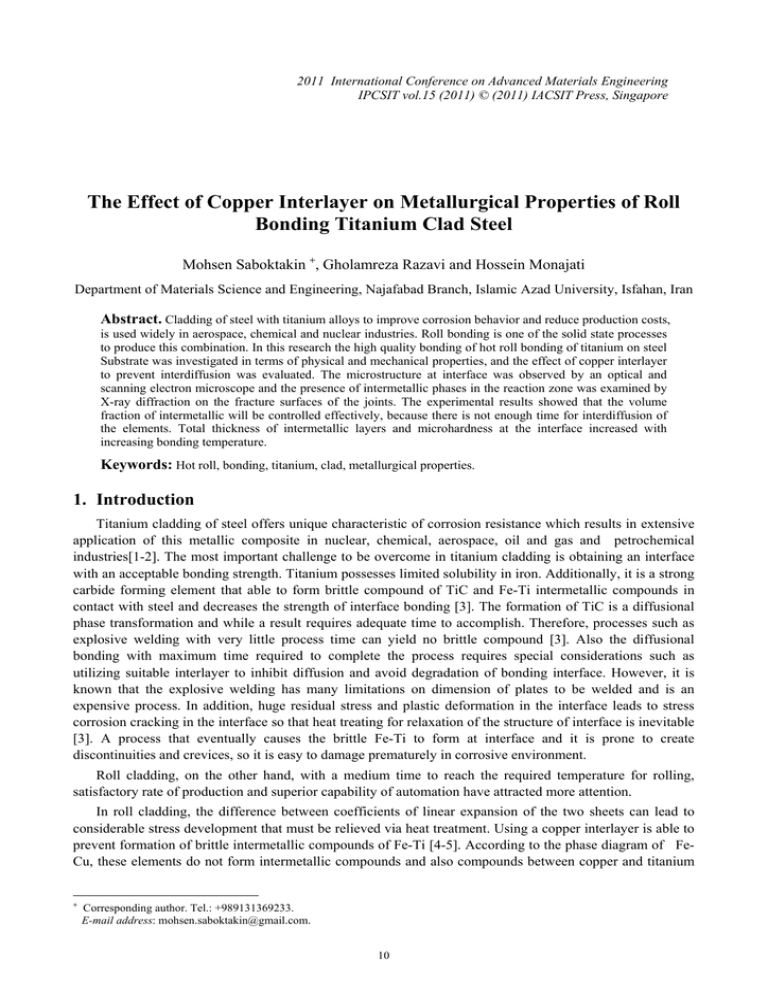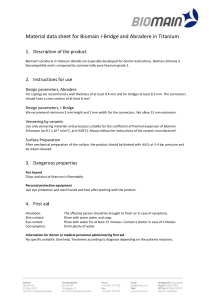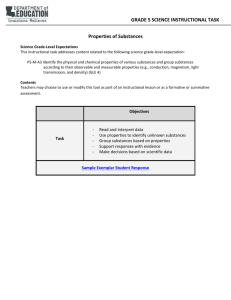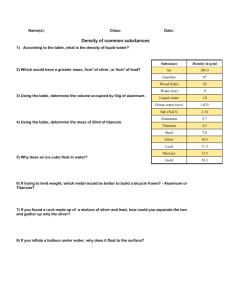Document 13135724
advertisement

2011 International Conference on Advanced Materials Engineering IPCSIT vol.15 (2011) © (2011) IACSIT Press, Singapore The Effect of Copper Interlayer on Metallurgical Properties of Roll Bonding Titanium Clad Steel Mohsen Saboktakin +, Gholamreza Razavi and Hossein Monajati Department of Materials Science and Engineering, Najafabad Branch, Islamic Azad University, Isfahan, Iran Abstract. Cladding of steel with titanium alloys to improve corrosion behavior and reduce production costs, is used widely in aerospace, chemical and nuclear industries. Roll bonding is one of the solid state processes to produce this combination. In this research the high quality bonding of hot roll bonding of titanium on steel Substrate was investigated in terms of physical and mechanical properties, and the effect of copper interlayer to prevent interdiffusion was evaluated. The microstructure at interface was observed by an optical and scanning electron microscope and the presence of intermetallic phases in the reaction zone was examined by X-ray diffraction on the fracture surfaces of the joints. The experimental results showed that the volume fraction of intermetallic will be controlled effectively, because there is not enough time for interdiffusion of the elements. Total thickness of intermetallic layers and microhardness at the interface increased with increasing bonding temperature. Keywords: Hot roll, bonding, titanium, clad, metallurgical properties. 1. Introduction Titanium cladding of steel offers unique characteristic of corrosion resistance which results in extensive application of this metallic composite in nuclear, chemical, aerospace, oil and gas and petrochemical industries[1-2]. The most important challenge to be overcome in titanium cladding is obtaining an interface with an acceptable bonding strength. Titanium possesses limited solubility in iron. Additionally, it is a strong carbide forming element that able to form brittle compound of TiC and Fe-Ti intermetallic compounds in contact with steel and decreases the strength of interface bonding [3]. The formation of TiC is a diffusional phase transformation and while a result requires adequate time to accomplish. Therefore, processes such as explosive welding with very little process time can yield no brittle compound [3]. Also the diffusional bonding with maximum time required to complete the process requires special considerations such as utilizing suitable interlayer to inhibit diffusion and avoid degradation of bonding interface. However, it is known that the explosive welding has many limitations on dimension of plates to be welded and is an expensive process. In addition, huge residual stress and plastic deformation in the interface leads to stress corrosion cracking in the interface so that heat treating for relaxation of the structure of interface is inevitable [3]. A process that eventually causes the brittle Fe-Ti to form at interface and it is prone to create discontinuities and crevices, so it is easy to damage prematurely in corrosive environment. Roll cladding, on the other hand, with a medium time to reach the required temperature for rolling, satisfactory rate of production and superior capability of automation have attracted more attention. In roll cladding, the difference between coefficients of linear expansion of the two sheets can lead to considerable stress development that must be relieved via heat treatment. Using a copper interlayer is able to prevent formation of brittle intermetallic compounds of Fe-Ti [4-5]. According to the phase diagram of FeCu, these elements do not form intermetallic compounds and also compounds between copper and titanium + Corresponding author. Tel.: +989131369233. E-mail address: mohsen.saboktakin@gmail.com. 10 are not very brittle [6]. Furthermore, a relatively low melting point of copper and its high plasticity makes it’s an appropriate choice. In this investigation, roll cladding of commercial pure titanium on plain carbon steel using a copper interlayer were performed and properties of interface were evaluated. 2. Materials and method CP titanium and plain carbon steel sheets in dimensions of 150×100×2 mm3 with the compositions shown in the table 1 was used and commercial pure copper foil used as the interlayer. Table 1: Chemical compositions of the base metals. Element C Ti Mn H O N P S Fe Ti 0.02 Bal - 0.01 0.25 0.03 - - 0.03 Steel 0.12 - 0.05 - - - 0.05 0.6 Bal. The sheets were fixed together and put in a furnace with neutral atmosphere in the temperature range of 800-900°C. Preheating were prolonged for 40 minutes and then to reach to a true strain of 30 pct, the sandwiches subjected to hot rolling and eventually located in a furnace of neutral atmosphere to cool down gradually. Microstructural features of the hot rolled sandwiches were characterized using optical microscope and scanning electron microscope (SEM). Compositional analysis of the compound was performed by EDX of the SEM. The Jefree linear method of grain size measurement was utilized to evaluate the grain size of the specimens. A solution of 3% Nital was used for etching the steel and the Kroll’s solution utilized for the titanium section. For determination of different phases in matrix of steel and titanium an X-ray diffractometer of Philip X’Pert model was employed. The strength of the bonding between layers was determined using peeling test according to ASTM standard D1876 and in a tension test apparatus of the model Instron 4486. A microhardness tester with Vickers indenter and a load of 37.63 g was employed to assess the mechanical strength of the cladding, interface and sublayer at room temperature. Microhardness measurement was performed at distances of 25, 50, 100 and 200 µm surrounding the interface in order to depict the profile of hardness. 3. Results and discussions The experimental results show that the Titanium cladding on steel via hot rolling with the rolling mill machine in the preheating temperature range of 800-900°C was applicable. That was because of the hexagonal crystal structure of the α-titanium that possesses limited slip systems. Therefore, there is high resistance to plastic deformation which is essential in tearing away oxide film of titanium and exposing virgin metal surfaces to the copper foil. A fact that the crucial for achievement of metallurgical bonding and is due to the high reduction in thickness during rolling process. Hence the temperature was lower than 800°C and it is not sufficient for the formation of bonds considering the capability of the rolling mill. On the other hand, titanium and copper form eutectic composition in temperatures beyond 900°C that increases intermetallic compounds along titanium copper interface resulting in cracking and separation in interface of the cladding and substrate[6]. Optical micrographs of the Cross-section of the titanium/copper/steel interface and The grain size of the parent metals for the samples joined and at temperatures of 800, 850 and 900°C are shown in Figure 1. experimental results show that the increasing the temperature of the preheating was lead to increase of the grain size of both sections of titanium and steel . 11 Fig. 1: Optical micrographs of the Cross-section of the titanium-copper-steel interface and the grain size of the parent metals for the samples joined at temperatures of 800, 850 and 900°C Figure 2 show the SEM image of Fe-Cu interface of roll bonded joints with a rolling reduction of 30% at bonding temperature of 900 °C, According of this figure at the Fe-Cu interface has no obvious reaction or diffusion layer. The extent of diffusion between iron and copper is limited [7]. Fig. 2: SEM image of steel-copper interface at 900°C with rolling reduction of 30% Figure 3 shows the SEM images of Ti-Cu interface at bonding temperatures of 800, 850, 900°C and element distribution profile of the interface of Ti-Cu bonded at the bonding temperature of 900°C, It can be seen from Fig. 3 that three transition layers formed at Cu-Ti interface and the thickness of the layers varies with chemical composition, the possible phase and the bonding temperature. The thickness of 3layers is shown in Table 3, determined by the results tested by energy spectrum (EDX) and Ti-Cu binary phase diagram. The total thickness of the intermetallic layers at the Cu-Ti interface increases with bonding temperature due to diffusion distance of Cu and Ti increases. The intermetallics of TiCu4, Ti2Cu3, Ti3Cu4, TiCu and Ti2Cu and their mixture formed in the transition layers [8]. Fig. 3: SEM images of Ti-Cu interface at bonding temperatures of a)800, b)850, c)900°C and element distribution profile of the interface of Ti-Cu bonded at the bonding temperature of 900°C 12 According of this results thickness of this triple layer depends on the temperature and increased with increase of the preheating temperature. The proposed reason for this trend in addition to increase in diffusion coefficient of both titanium and copper is the less close-packed BCC structure of titanium in temperatures above 882°C which is suitable for copper atoms to diffuse into the open structure [9]. Table 2: Chemical composition, possible phase and thickness of intermetallic layers between Cu and Ti Bonding temperature °C 800 850 900 Intermetallic layer Possible phase Thickness m 1 Ti2Cu3+TiCu4 2.6-3.7 2 TiCu+Ti3Cu4 1-1.7 3 Ti2Cu+Ti 2-4.7 1 Cu+TiCu4 4.5-6 2 Ti2Cu 2-3 3 TiCu+Ti2Cu 2-3 1 Ti2Cu3+Ti3Cu4 17-42 2 Ti2Cu+TiCu 7-11 3 Ti2Cu+Ti 10.5-13.5 Cu–Ti interface is characterised by the presence of the Widmanstatten α–β titanium structure. Copper is a strong β-stabiliser element. Migration of copper atom to titanium lattice lowers the eutectoid transformation temperature of titanium and α-β phase structure forms owing to decomposition of β-Ti during cooling [10-11]. This structure showed in figure 4. Fig. 4: SEM images of the Widmanstatten α–β titanium structure formed in Ti-Cu interface The peel strength of hot roll bonded joints at different bonding temperature and is shown in figure 5. Fig. 5: Schematic illustration of peeling test and Variation of the peeling force in as-received strips in the different temperature The average peel strength was determined using the following equation: Average Peel Strength = (Average Load/ Bond With) (1) The peel strength of roll bonded joints decreases with increasing bonding temperature It may be because of the increase in the total thickness of intermetallic layers and brittleness of bonded joints. 13 4. Conclusions • 1. Copper interlayer can block the elements diffusion between titanium alloy and stainless steel. • 2. There is no reaction or diffusion layer at the stainless Fe-Cu interface. The reaction layers at the interface of Cu-Ti consist of TiCu4, Ti2Cu3, Ti3Cu4, TiCu and Ti2Cu and their mixtures. • 3. The intermetallic compound that formed in Ti-Cu caused decreases of average peel strength. 5. Reference [1] S. N. Polyanskii and V. S. Kolnogorov. Cladded steel for the oil and gas industries. Chemical and Petroleum Engineering. 2002, 38: 11–12. [2] G. E. Totten. Steel Heat treatment Handbook 2ed. Taylor & Francis, 2006. [3] N. Kahramana and B. Gulenc. Joining of titanium/stainless steel by explosive welding and effect on interface, Materials Processing Technology. 2005, 169: 127–133. [4] A. Elrefaey and W. Tillmann. Solid state diffusion bonding of titanium to steel using a copper base alloy as interlayer. Materials Processing Technology. 2009, 209: 2746–2752. [5] T. Fukuda and Y. Seino. Bonding strength and microstructure of bonding interface of hot rolled titanium clad steel. Iron and Steel Institute of Japan. 1989, 75: 94-101. [6] S. Kundu and S. Chatterjee. Characterization of diffusion bonded joint between titanium and 304 stainless steel using a Ni interlayer. Materials Characterization. 2008, 59: 631-637. [7] M. K. Lee and J. G. Lee. Interlayer engineering for dissimilar bonding of titanium to stainless steel. Materials letters. 2010, 64: 9, 1105-1108. [8] A. Elrefaey and W. Tillmann. Evaluation of Transient Liquid Phase Bonding Between Titanium and Steel. Advanced Engineering Materials. 2009, 11: 7, 556-560. [9] S. Dziallach and W. Bleck. Roll-Bonded Titanium/ Stainless-Steel Couples, Part1 Diffusion and Interface-Layer Investigation. Advanced Engineering Materials. 2009, 11: 1-2, 82-87. [10] R. Ferro and A. Saccoe. Intermetallic Chemistry. Elsevier, London, 2008. [11] C. Leyens and M. Peters. Titanium and Titanium Alloy. Wiley-VCH, Germany, 2003. 14



